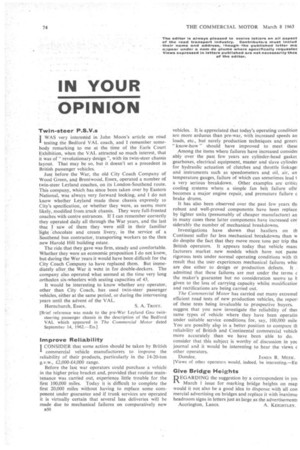IN YOUR OPINION
Page 76

If you've noticed an error in this article please click here to report it so we can fix it.
Twin-steer P.S.V.s
WAS very interested in John Moon's article on road testing the Bedford VAL coach, and 1 remember. somebody remarking for me at the time of the Earls Court Exhibition, when the VAL attracted so much interest, that it was of" revolutionary design ", with its twin-steer chassis layout. That may be so, but it doesn't set a precedent in British passenger vehicles.
Just before • the War, the old City Coach Company of Wood Green, and Brentwood, Essex, operated a number of twin-steer Leyland coaches, on its London-Southend route. This company, .which has since been taken over by Eastern National, was always very forward looking, and I do not know -whether Leyland made these chassis expressly to City's specification,. or whether they were, as seems more likely, modified from.truck chassis. They were full-fronted coaches with centre entrances. If I can remember correctly they operated daily all through the War years, and the last that I saw. of them they were still in their familiar 'light -chocolate and cream livery, in the service of a .Southend bus contractor, .transporting workers to the then new Harold Hill building estate.
The ride that they gave was firm, steady and comfortable. Whether they were an economic proposition 1 do not know, but during the War years it would have been difficult for the City Coach Company to have replaced them. But immediately after, the War it went in for double-deckers. The company also operated what seemed at the time very long orthodox six-wheelers with seating capacities of 43.
It would be interesting to know whether -any operator, other than City Coach,, has used twin-steer passenger vehicles, either at the same period, or during the intervening yearsuntil the advent of the VAL.
Hornchurch, Essex, S. A. TROTT.
[Brief reference was made to the pre-War Leyland Gnu twinsteering passenger chassis in the description of the Bedford VAL which appeared in • The Commercial Motor • dated September 14,.1962.—Eo.] Improve Reliability I CONSIDER that some action should be taken by British I commercial vehicle manufacturers to improve the reliability of their products, particularly in the 14-20-ton g.v.w., £2,000-£4,000 range.
Before the last war operators could purchase a vehicle in the higher price bracket and, provided that routine maintenance was carried out, experience little trouble for, the first 100,000 miles. Today it is difficult to complete the first 20,000 miles without having to replace some component under guarantee and if trunk services are operated it is virtually certain that several late deliveries will be made due to mechanical failures on comparatively new
B50 vehicles. It is appreciated that today's operating condition are more arduous than pre-war, with increased speeds an loads, etc., but surely production techniques and genen " know-how ". should have improved to meet these
Among the items where failures have increased considet ably over the past few years are cylinder-head gasket gearboxes, electrical equipment, master and slave cylindei for hydraulic actuation of clutches and throttle linkage, and instruments such as speedometers and oil, air, an temperature gauges, failure of which can sometimes lead t a very serious breakdown. Other examples are critic cooling systems where a simple fan belt failure ofte becomes a major engine repair, and premature failure c brake drums.
It has also been observed over the past few years thu robust and well-proved components have been replace by lighter units (presumably of cheaper manufacture) an in many cases these latter components have increased cor siderably the number of mechanical breakdowns.
Investigations have shown that hauliers on th Continent suffer far less mechanical, breakdowns than w do despite the fact that they move more tons per trip tha British operators. It appears today that vehicle mans facturers market . new models which have not passe rigorous tests under normal operating conditions with ft result that the user experiences mechanical failures whic are due either to design or production defects. It admitted that these failures are met under the terms c the maker's guarantee but no consideration seemsto h given to the loss of carrying capacity whilst modificatior and rectifications are being carried out.
The Commercial Motor has carried out many extreme] efficient road tests of new production vehicles, the reporl of these tests being invaluable to prospective buyers. suggest that you now investigate the reliability of the same types of vehicle where they have been operatin under suitable service conditions for, say, 100,000 mile You are possibly alsr in a better position to compare th reliability of British and Continental commercial vehicli more accurately than we have been able to do. consider that this subject is worthy of, discussion in yot journal and it would be interesting to hear the views c other operators.
Dundee. JAMES R. MEEK. [Views of other operators would, indeed, be interesting.—Ec Give Bridge HeightS , REGARDING the suggestion by a correspondent in yot March 1 issue for marking bridge heights op map would it not also be a good idea to dispense with all con mercial advertising on bridges andreplace it With inaximuj headroom signs in letters just as large as the advertisement
Accrington, Lancs. A. KEIGHTLEY.




















































































































